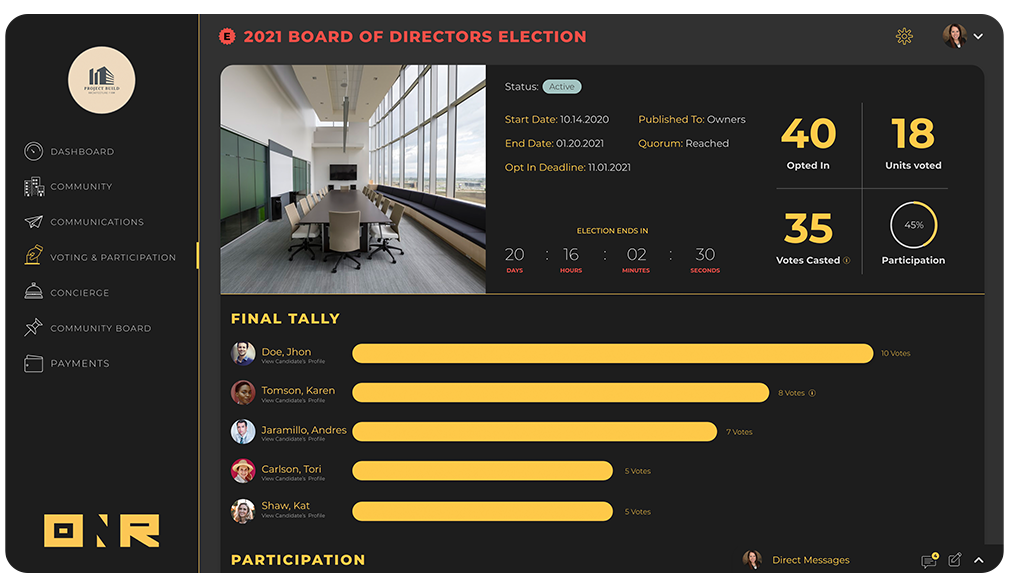According to HOA-USA, almost 53% of American homeowners live in a Condo & HOA and most newly built homes are part of an association. Living in a Community Association has a number of potential benefits, but people often are unsure about how decisions are made or how the Community Association board operates. When a Condo or HOA isn’t transparent or feels confusing, it can cause a lot of stress and make owners feel like their voices aren’t being heard.
One of the reasons we created the ONR Community Management Platform was to take the mystery out of Community Association and property management to help bring people together. Today, we’re breaking down some of the basics of a Community Association board: its members, their responsibilities, and what their requirements are, to arm you with everything you need to understand Condo & HOA living.
What is a Community Association Board of Members?
Generally speaking, a Community Association board is made up of four to five elected volunteers who fill several key roles (more on those later). As a whole, their job is to manage the finances of the Condo & HOA, help coordinate the maintenance of common areas, enforce any governing documents, and make specific strategic decisions for the community. Some Community Association will try to recruit potential board members, and others rely on people proactively volunteering themselves. In the past, many people have avoided volunteering for board positions because it was hard to make time. Luckily, digital tools are making it much easier for people to schedule meetings and guide important decisions in their communities.
What are the Different Community Association Member Roles?
Typically, there are four main roles that make up a Community Association Board:
President
Just like a CEO, an association president is the face of the association. They are in charge of scheduling and overseeing meetings, arranging votes, signing documents, and coordinating with managers. In some cases, an HOA or Condo president will have the final say on certain decisions and projects. Because of that, a Community Association president is the authority on all of the association rules, bylaws, and procedures. A great president is also effective at running meetings, keeping them on topic, and engaging with other voices in the community.
Vice President
A Community Association vice president shares almost all the responsibilities of the president. In fact, if the president is ever away or unable to take care of any HOA & Condo business, it falls onto the vice president to take care of it. As such, a vice president has to be just as knowledgeable about the rules, bylaws, procedures, and ongoing projects. An effective Community Association may also delegate certain projects or responsibilities to the vice president.

Treasurer
The treasurer is the source of truth and an expert on association budgets and finances. They handle collections and billing, as well as overseeing how the association money is being spent. The treasurer is also responsible for dealing with a Community Association’s tax responsibilities.
Secretary
An association secretary keeps track of all important documents and records. It’s also their job to make sure relevant records are kept up to date and any legal documents are submitted. A Community Association secretary is also instrumental in coordinating meetings, helping the president set an agenda, and recording minutes.
 Member-At-Large
Member-At-Large
Not all Community Associations have this role, but these are people who serve as a go-between between an HOA & Condo board and the rest of the community. They sit in on meetings, pass on feedback and concerns, and help bridge the gap between an association and its members. Modern digital tools make this role somewhat obsolete since it’s much easier to keep communities up to date on new projects and developments.
Making Community Association Boards Smarter and More Transparent
A basic understanding of your Community Association is a great foundation for getting more involved with important decisions that affect your community. But ask around, and it won’t take long to find someone who has nothing but bad things to say about living in a Community Association. Common complaints are that HOA & Condos processes are outdated, inefficient, not transparent, or favor only a small group of people. When a Community Association Board and the community they serve can’t engage with one another, it can cause real friction.
ONR’s digital community platform was specifically designed to streamline association processes, so it’s easier for owners and members to communicate, weigh in on issues, find documents, hold elections, and more. To learn more about how we’re helping Community Association Board Members operate more efficiently and transparently, contact us today.






 Member-At-Large
Member-At-Large